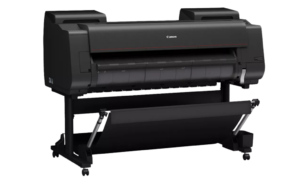Frequently Asked Questions
What kind of large format printer do you use?
Our production printer is a Canon ImagePROGRAF Pro-4600

It’s a pretty impressive piece of equipment. We think you’ll love what we can do with it.
What small format stuff can you print?
For our small format printing, we have a Xerox enterprise class color laser printer. It will print full color up to 11×17 tabloid size paper. Enterprise class laser printers have a much more robust print engine than small business, workgroup or desktop printers and are capable of laying down a lot more color without leaving stripes and voids.
With this printer, we can easily create
- Food Menus
- Rack Cards
- Flyers
- Mailers
- Newsletters
- … Really, anything you can think up, we can probably print.
How big can you print my photo?
That’s a pretty loaded question. It all depends on how many pixels you have and at what resolution. I couldn’t even begin to explain it better than our friends at Bellevue Fine Art Reproductions…
What is “PPI”? Isn’t it the same as “DPI”?
There is a lot of confusion about the acronyms DPI (Dots Per Inch) and PPI (Pixels Per Inch). This is understandable, given that people often use the terms interchangeably when they have very different meanings. So what do DPI and PPI mean, and how do they apply to printed photographs and digital image files?
DPI stands for dots per inch and describes the density of ink dots placed on a sheet of paper (or another photographic medium) by a printer to create a physical print. DPI has nothing to do with anything displayed digitally.
PPI stands for pixels per inch and describes the resolution of a digital image, not a print.
What is a “Print Ready Image”?
Print-ready files are setup & sized to print without additional re-formatting. Your images should be:
- Exactly 300 ppi at the size you want the print
- In the Adobe RGB 1998 Color Space
- Include a color profile (Adobe 1998 is recommended)
- JPG (100%), TIF, or PDF formats are best
- Include any margin you want the print to have
The only thing we can’t really help with or “fix” is the resolution of the image. For best results, it should be a minimum of 300 ppi. For more information on this, please check out this video by Bellevue Fine Art.
What is giclée?
Giclée (pronounced zhee-clay) printing refers to a high-quality method of producing fine art prints using inkjet technology, where the printer sprays ink onto paper or canvas. The term comes from the French word “gicleur,” meaning “to spray,” and is associated with archival quality prints that use pigment-based inks for durability and color accuracy.
For further reference see:
Can’t I just use my own deskjet to make a giclée print?
Short answer, no.
First, large industrial printers like ours have finer print heads, and are capable of using thicker and more varied paper. In fact many of the top art paper and canvas manufacturers have made special paper just for giclée printers, that better hold the ink and ensure longevity and archival quality of the prints. Secondly the ink is different, and is of a much higher quality than standard printer ink. Lastly, the printers themselves are very large, allowing for printing of up to 44″ wide, with virtually no limit to the length.
More infomation on giclée printing can be found in this Wikipedia’s article.